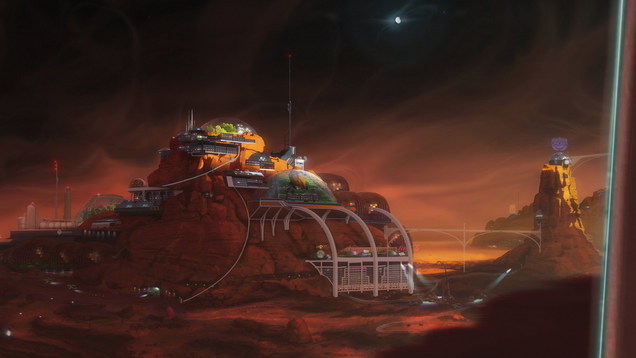

Robinson populates his book with many such “sense of wonder” descriptions of the Martian landscape to draw in the reader and to give the reader an appreciation for the natural environment.

Stars were popping out everywhere, and the maroon sky shifted to a vivid dark violet, an electric color that was picked up by the dune crests, so that it seemed crescents of liquid twilight lay across the black plain. Now the sky was a maroon dome, the high clouds the pink of moss campion. The little button sun sank under the black line to the west. The sun was a little gold button, and above it shown two evening stars: Venus, and the Earth….The sun touched the horizon, and the dune crests faded to shadow.

Something in the sand caught at the light, and the dunes were distinctly purplish. The clouds Ann had mentioned were bright yellow streaks, caught very high in the sky. The sky was a dark red, murky and opaque, only slightly lighter in the west over the sun. They head for the north pole of Mars, and Robinson describes the landscape lovingly: Early in the book, Nadia Cherneshevsky, an engineering genius from Siberia, is laid up by an injury and agrees to join a geology survey with geologist Ann Clayborne, another of the book’s remarkable characters. These descriptions are remarkable and still hold up well given that Robinson wrote before many of the discoveries of the mid-‘90s. Robinson’s glittering descriptions of the Martian landscape can leave the reader wanting more - both the original landscape when the First Hundred arrive, and the landscape they shape in the process of terraforming. As civilization is established on Mars, the tools of survival gradually become more sophisticated as well, and these tools eventually create many of the conflicts that propel the characters across the surface of Mars. The tale covers a large tapestry of places, technological marvels, and years. Some come from a chaotic Earth, some are home-grown: massive dirigibles genetically engineered microorganisms for terraforming the planet lightweight “tenting” material capable of providing domes to cover entire cities stealthy rovers space elevators life-extension treatments and on and on. The “First Hundred” astronaut-colonists are sent to Mars aboard a massive rotating spacecraft made of Space Shuttle External Tank segments, and the toys only get better from there. I don’t agree with everything the author says in the book, but I still believe strongly that this book is well worth reading.įrom a technological level, Robinson populates the book with massive, vehicles and tools that NASA and Russia could only dream about in the best of times. Like Dune and other great science fiction epics, the book succeeds on a variety of levels, including technology, environment, and characterization. Kim Stanley Robinson’s Red Mars falls into this category. Some books are worth reading more than once. Publisher: Bantam House Science Fiction (Spectra)


 0 kommentar(er)
0 kommentar(er)
